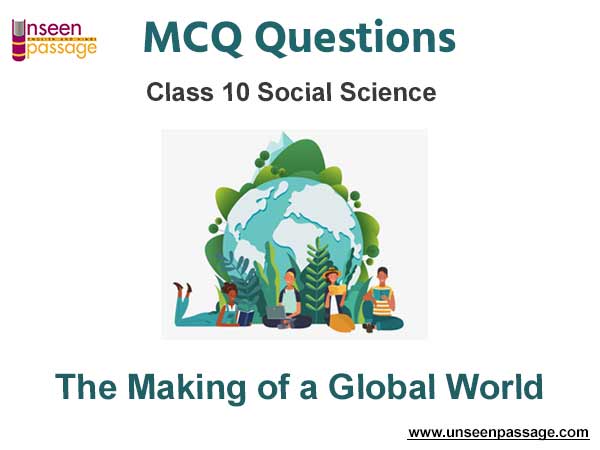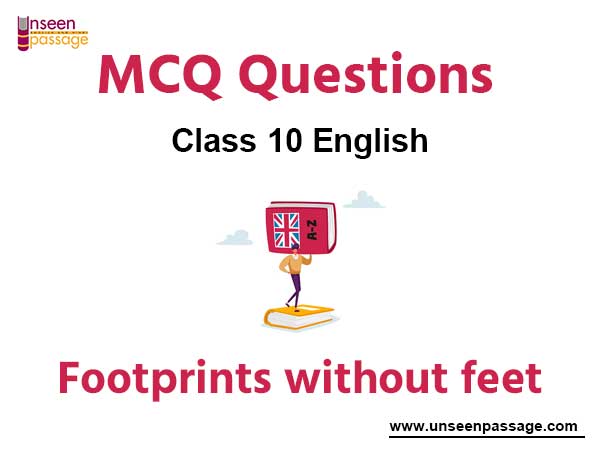The Making of a Global World MCQ Class 10 Social Science
Please refer to Chapter 3 The Making of a Global World MCQ Class 10 Social Science with answers below. These multiple-choice questions have been prepared based on the latest NCERT book for Class 10 Social Science. Students should refer to MCQ Questions for Class 10 Social Science with Answers to score more marks in Grade 10 Social Science exams. Students should read the chapter The Making of a Global World and then attempt the following objective questions.
MCQ Questions Class 10 Social Science Chapter 3 The Making of a Global World
The The Making of a Global World MCQ Class 10 Social Science provided below covers all important topics given in this chapter. These MCQs will help you to properly prepare for exams.
Question. Indian traders and money-lenders followed European colonizers into:
(a) Britain
(b) India
(c) Africa
(d) China
Answer
C
Question. Between 1812 and 1871, the share of raw cotton exports rose from:
(a) 10 percent to 35 percent
(b) 15 percent to 40 percent
(c) 5 percent to 35 percent
(d) 5 percent to 40 percent
Answer
C
Question. After the war, Britain borrowed large sums of money from:
(a) China and India
(b) German banks and German public
(c) Russian banks and Russian public
(d) US banks and US public
Answer
D
Question. Britain grew opium in India and exported it to:
(a) Japan
(b) Africa
(c) Germany
(d) China
Answer
D
Question. When Britain was pre-occupied with war, industries had developed in:
(a) India and Japan
(b) India and China
(c) Japan and Korea
(d) Japan and China
Answer
A
Question. Before the war, eastern Europe was a major supplier of:
(a) Rice in the world market
(b) Wheat in the world market
(c) Tea in the world market
(d) None of the above
Answer
B
Question. By the 1890s, South Africa contributed over 20 percent of the world:
(а) Iron production
(b) Copper production
(c) Silver production
(d) Gold production
Answer
D
Question. The US economy resumed its strong growth in the early:
(a) 1920s
(b) 1930s
(c) 1940s
(d) 1950s
Answer
A
Question. The IMF and the World Bank commenced financial operations in:
(a) 1927
(b) 1937
(c) 1947
(d) 1957
Answer
C
Question. Most India’s indentured workers came from the present-day region of:
(a) Uttar Pradesh and Bihar
(b) Central India and Tamil Nadu
(c) Uttar Pradesh, Bihar and Tamil Nadu
(d) Uttar Pradesh, Bihar, Central India and Tamil Nadu
Answer
D
Question. By 1933 over 4,000 banks had closed and between 1929 and 1932 about:
(a) 1,00,000 companies had closed
(b) 2,00,000 companies had closed
(c) 1,10,000 companies had closed
(d) 2,10,000 companies had closed
Answer
C
Question. The Financial Conference of July, 1944 was held at:
(a) Bretton Woods in New York, USA
(b) Bretton Woods in Sydney, Australia
(c) Bretton Woods in Tokyo, Japan
(d) Bretton Woods in New Hampshire, USA
Answer
D
Question. During the war, industries were restructured to produce:
(a) Help-related goods
(b) More armaments
(c) War-related goods
(d) All the above
Answer
B
Question. The dollar was anchored to gold at a fixed price of:
(a) $ 25 per ounce of gold
(b) $ 30 per ounce of gold
(c) $ 35 per ounce of gold
(d) $ 40 per ounce of gold
Answer
C
Question. A well-known pioneer of mass production was the:
(a) Car manufacturer General Motors
(b) Motorcycle manufacturer Honda
(c) Car manufacturer Henry Ford
(d) None of the above
Answer
C
Question. China had been cut off from the post-war world economy since its revolution in:
(a) 1946
(b) 1947
(c) 1948
(d) 1949
Answer
D
Question. The country that had made huge sacrifices to defeat Nazi Germany was:
(a) USA
(b) Japan
(c) Soviet Union
(d) England
Answer
C
Question. Buddhism emerged from eastern India and spread in several directions through intersecting points on:
(a) The western side
(b) The sea routes
(c) The silk routes
(d) None of the above
Answer
C
Question. The Portuguese and Spanish conquest and colonisation of America was decisively under way by the:
(a) Mid-fourteenth century
(b) Mid-fifteenth century
(c) Mid-sixteenth century
(d) Mid-seventeenth century
Answer
C
Question. Fordist industrial practices was widely copied in Europe in the:
(a) 1940s
(b) 1930s
(c) 1920s
(d) 1910s
Answer
C
Question. Nearly 50 million people emigrated from Europe to America and Australia:
(а) In the nineteenth century
(b) In the third century
(c) In the eighteenth century
(d) In the seventeenth century
Answer
A
Question. Car production in the US rose from in 1919 to more than in 1929:
(a) 5 million, 4 million
(b) 3 million, 5 million
(c) 4 million, 5 million
(d) 2 million, 5 million
Answer
D
Question. Recruitment was done by agents engaged by employer and:
(а) Paid a small commission
(b) Paid a big commission
(c) Given land
(d) None of the above
Answer
A
Question. ‘Chutney music’ became popular in:
(a) Trinidad and Guyana
(b) Trinidad
(c) Guyana
(d) none of the above
Answer
A
Question. Indentured labour was abolished in :
(a) 1921
(b) 1931
(c) 1941
(d) 1951
Answer
A
Question. The US became a colonial power in the late 1890s by taking over some colonies earlier held by:
(a) Berlin
(b) British
(c) France
(d) Spain
Answer
D
Question. Mahatma Gandhi launched the Civil Disobedience Movement at the height of the depression in:
(a) 1931
(b) 1941
(c) 1951
(d) 1961
Answer
A
Question. The First World War was fought mainly between two power blocs. One side were Britain, France and Russia and on the opposite side were:
(a) Germany, Japan and China
(b) Germany, Austria and Ottoman Turkey
(c) Germany, Austria-Hungary and Ottoman Turkey
(d) None of the above.
Answer
C
Question. The Great Depression began around 1929 and lasted till the:
(a) Mid-1940s
(b) Mid-1980s
(c) Mid-1950s
(d) Mid-1920s
Answer
B
Question. A fast-speeding disease of cattle plague or rinderpest had a terrifying impact on people’s livelihood and the local economy, in Africa in the:
(a) 1860s
(b) 1870s
(c) 1880s
(d) 1890s
Answer
D
True or False :
Question. The world did not change profoundly in the nineteenth century.
Answer
False
Question. The pre-modern world shrank greatly in the sixteenth century after European sailors found a sea route to Asia.
Answer
True
Question. Food offers many examples of long distance cultural exchange.
Answer
True
Question. Europe’s rich began to eat better and live longer with the introduction of the humble potato.
Answer
False
Question. Economists identify, three types of movement or ‘flows’ within inter-national economic exchanges.
Answer
True
Question. The Portuguese and Spanish conquest and colonisation of America was decisively under way by the mid-sixteenth century.
Answer
True
Question. A good place to start is the changing pattern of food production and consumption in industrial Soviet.
Answer
False
Question. Many expedition set off in search of El Dorado, the fabled city of silver.
Answer
False
Question. Population growth for the late eighteenth century had increased the demand for food grains in Britain.
Answer
True
Question. Dissenter refers to one who accepts established beliefs and practices.
Answer
False
Question. After the Corn Law were scrapped, food could be imported into US more cheaply than it could be produced within the country.
Answer
False
Question. Precious metals such as silver enhanced Europe’s wealth and financed its trade with Asia.
Answer
False
Question. By the eighteenth century, China and India were among the world’s richest countries.
Answer
True
Question. Many foods were only introduced in Europe and Asia after Christopher Columbus accidently discovered the vast continent.
Answer
True
Question. In the mid-1850s hundreds of thousands died of starvation.
Answer
False
Fill in the blanks :
Question. The withdrawal of US ……………………… affected much of the rest of the world.
Answer
towns
Question. Growing food and other crops for the world market required ……………………… .
Answer
capital
Question. During the war, industries were restructured to produce ……………………… goods.
Answer
war-related
Question. The housing and consumer boom of the 1920s created the basis of prosperity in the ……………………… .
Answer
US
Question. The boom transferred the US from being an international debtor to an international ……………………… .
Answer
creditors
Question. Economists and ……………………… drew two key lessons from inter-war economic experiences.
Answer
politicians
Question. Fine ……………………… produced in India were exported to Europe.
Answer
Cotton
Question. ……………………… manufactures also began to seek overseas markets for their cloth.
Answer
British
Question. Opium shipments to ……………………… grew rapidly from the 1820s to become for a while India’s single largest export.
Answer
China
Question. Mass production lowered costs and prices of ……………………… goods.
Answer
engineered
Question. The ……………………… prosperity of the 1920s now disappeared in a puff of dust.
Answer
consumerist
Question. The First World War was mainly fought in ……………………… .
Answer
Europe
Question. The ……………………… was the world’s first produced by man car.
Answer
T. Model Ford
Question. From the 1900s ……………………… nationalist leaders began opposing the system of indentured labour migration as abusive and cruel.
Answer
Indian

We hope you liked the above The Making of a Global World MCQ Class 10 Social Science. In case you have any questions please put them in the comments box below and our teachers will provide you a response.


